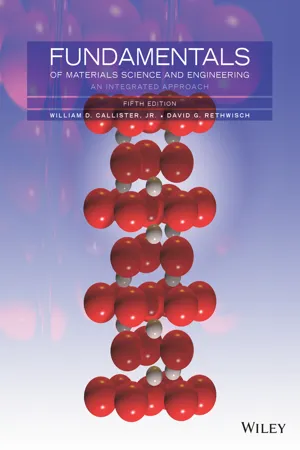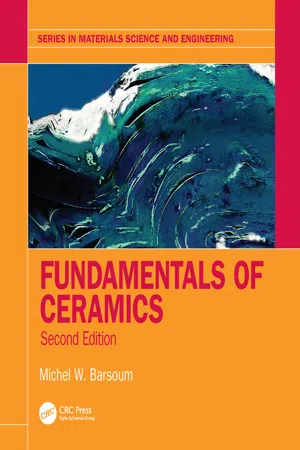Chemistry
Ionic Bonding
Ionic bonding is a type of chemical bond that forms between ions of opposite charges. It occurs when one atom transfers electrons to another, resulting in the formation of positively and negatively charged ions. These ions are then attracted to each other due to their opposite charges, creating a strong bond between the atoms.
Written by Perlego with AI-assistance
Related key terms
Related key terms
1 of 4
Related key terms
1 of 3
11 Key excerpts on "Ionic Bonding"
- No longer available |Learn more
- Steven Boone, Drew H. Wolfe(Authors)
- 2011(Publication Date)
- Collins Reference(Publisher)
CHAPTER 10Chemical Bonding: Fundamental Concepts
A chemical bond is the force of attraction that one atom (or ion) has for another atom (or ion). The principal driving force for atoms to combine and form molecules is the release of energy by atoms as they stabilize through bonding. The two principal types of bonds discussed in this chapter are ionic and covalent bonds.10.1 INTRODUCTION TO CHEMICAL BONDINGChemical bonds are the forces that hold atoms together when compounds are formed. Ionic or Electrovalent BondsIonic bonds most commonly result when one or more electrons transfer from a metal to a nonmetal. When this occurs, the metal atom becomes a cation, and the nonmetal atom becomes an anion. Ionic bonds are the electrostatic forces of attraction among the resulting positive and negative ions.Covalent BondsA covalent bond results when the orbitals of two nonmetal atoms overlap and the nuclei of the atoms attract the electrons in the overlapping region. This is called electron sharing .Bonding TheoriesThe valence bond and molecular orbital theories are most often used to explain the properties and formation of chemical bonds. The Valence Bond Theory primarily considers the interactions of the electrons in the outer shell (valence electrons) in the formation of bonds. The Molecular Orbital Theory considers the energies of all the electrons in the atoms that form chemical bonds. Scientists use both theories to explain chemical bonds and molecular structures, because neither can explain adequately the bonds in all chemical species.Lewis Symbols and Lewis FormulasThe valence electron configurations of the atoms are often shown using Lewis symbols and Lewis structures. To write the Lewis symbol of an atom, place as many dots around its symbol as there are valence electrons. For example, one way to write the Lewis symbol of N is shown in Figure 10.1. Five dots are placed around the symbol of nitrogen because it has five valence electrons, 2s2 2p3 - eBook - ePub
Chemistry for Pharmacy Students
General, Organic and Natural Product Chemistry
- Lutfun Nahar, Professor Satyajit D. Sarker(Authors)
- 2019(Publication Date)
- Wiley(Publisher)
Ionic bonds result from the transfer of one or more electrons between atoms. The more electronegative atom always gains one or more valence electrons, and hence becomes an anion. The less electronegative atom always loses one or more valence electrons, and becomes a cation. A single‐headed arrow indicates a single electron transfer from a less electronegative atom to the more electronegative atom. Ionic compounds are held together by the attraction of opposite charges. Therefore, ionic bonds consist of the electrostatic attraction between positively and negatively charged ions.Ionic bonds involve the complete transfer of electrons between two atoms of widely different electronegativities, and both atoms obtain a stable octet outermost shell of electrons. Anions have usually gained sufficient electrons to complete their outermost shells. Cations have usually lost their outermost shells electrons, so that the next inner shells become the stable octet outermost shells. Thus, ionic bonds are commonly formed between reactive metals, electropositive elements on the left side of the periodic table, and non‐metals, electronegative elements on the right side of the periodic table (see Section 2.2 ). For example, Na (electronegativity: 0.9) easily gives up an electron, and Cl (electronegativity: 3.0) readily accepts an electron to form an ionic bond. In the formation of ionic compound Na+ Cl− , the single 3s valence electron of Na is transferred to the partially filled valence shell of chlorine.2.3.4.2 Covalent Bonds
Covalent bonds are formed from the sharing of electron pairs between bonded atoms instead of giving up or gaining electrons. In this case, an atom can obtain a filled valence shell by sharing electrons. For example, two chlorine atoms can achieve a filled valence shell and form a chlorine molecule (Cl2 ). Similarly, hydrogen and fluorine can form a covalent bond by sharing electrons and form hydrogen fluoride (HF - eBook - ePub
Fundamentals of Materials Science and Engineering
An Integrated Approach
- William D. Callister, Jr., David G. Rethwisch(Authors)
- 2018(Publication Date)
- Wiley(Publisher)
For each type, the bonding necessarily involves the valence electrons; furthermore, the nature of the bond depends on the electron structures of the constituent atoms. In general, each of these three types of bonding arises from the tendency of the atoms to assume stable electron structures, like those of the inert gases, by completely filling the outermost electron shell. Secondary or physical forces and energies are also found in many solid materials; they are weaker than the primary ones but nonetheless influence the physical properties of some materials. The sections that follow explain the several kinds of primary and secondary interatomic bonds. 2.6 PRIMARY INTERATOMIC BONDS Ionic Bonding Ionic Bonding Ionic Bonding is perhaps the easiest to describe and visualize. It is always found in compounds composed of both metallic and nonmetallic elements, elements situated at the horizontal extremities of the periodic table. Atoms of a metallic element easily give up their valence electrons to the nonmetallic atoms. In the process, all the atoms acquire stable or inert gas configurations (i.e., completely filled orbital shells) and, in addition, an electrical charge—that is, they become ions. Sodium chloride (NaCl) is the classic ionic material. A sodium atom can assume the electron structure of neon (and a net single positive charge with a reduction in size) by a transfer of its one valence 3 s electron to a chlorine atom (Figure 2.11 a). After such a transfer, the chlorine ion acquires a net negative charge, an electron configuration identical to that of argon; it is also larger than the chlorine atom. Ionic Bonding is illustrated schematically in Figure 2.11 b. Figure 2.11 Schematic representations of (a) the formation of Na + and Cl − ions and (b) Ionic Bonding in sodium chloride (NaCl). coulombic force The attractive bonding forces are coulombic —that is, positive and negative ions, by virtue of their net electrical charge, attract one another - eBook - ePub
- Michel Barsoum(Author)
- 2019(Publication Date)
- CRC Press(Publisher)
Table 2.3 —was obtained by arbitrarily fixing the value of H at 2.2. With this scale, it becomes relatively simple to predict a bond's nature. If two elements forming a bond have similar electronegativities, they will tend to share the electrons between them and will form covalent bonds. However, if the electronegativity difference, ΔX, between them is large (indicating that one element is much greedier than the other), the electron will be attracted to the more electronegative element, forming ions which, in turn, attract each other. Needless to say, the transition between ionic and covalent bonding is far from sharp and, except for homopolar bonds that are purely covalent, all bonds will have both an ionic and a covalent character (see Prob. 2.16). However, as a quite rough guide, a bond is considered predominantly ionic when ΔX > 1.7 and predominantly covalent if ΔX < 1.7.TABLE 2.3 Relative electronegativity scale of the elements Each type of bond and how it leads to the formation of a solid is discussed separately below, starting with the simpler of the two, namely, the ionic bond.2.4 Ionic Bonding
Ionically bonded solids are made up of charged particles—positively charged ions, called cations , and negatively charged ions, called anions. Their mutual attraction holds the solid together. Ionic bonds are omnidirectional. Ionic compounds are typically hard and brittle and are poor electrical and thermal conductors.To illustrate the energetics of Ionic Bonding consider the bond formed between Na and Cl. The electronic configuration of Cl (atomic number Z = 17) is [1s2 2s2 2p6 ]3s2 3p5 , while that of Na (Z = 11) is [1s2 2s2 2p6 ]3s1 . For reasons that will become evident in a moment, when Na and Cl atoms are brought into close proximity, a bond will form by the transfer of an electron from the Na atom to the Cl atom, as shown schematically in Fig. 2.3 . The Na atom configuration becomes [1s2 2s2 2p6 ] and is now +1 positively charged; the Cl atom gains an electron, acquires a –1 negative charge, and its electronic structure becomes [1s2 2s2 2p6 ]3s2 3p6 . Note that after the charge transfer, the configuration of the Na and Cl ions correspond to those of the noble gases, Ne and Ar, respectively.FIGURE 2.3 (a ) Electron transfer from a Na atom to Cl atom results in the formation of, (b - eBook - ePub
- Michael Matson, Alvin W. Orbaek(Authors)
- 2013(Publication Date)
- For Dummies(Publisher)
Figure 8-3 . In this triangle, the three types of bonding (ionic, covalent, and metallic) are represented. For compounds with a simple AB formula, you can work out what kind of bonding is most likely based on the respective Pauling electronegativity. In real atoms, there is a combination of ionic and covalent character. The degree of the Ionic Bonding, or the percentage ionic character, can be determined for a particular system. If the difference in the electronegativity between two atoms in a solid is high (3 to 4), the system is 80 to 100 percent ionic; but if the difference in electronegativity is low (0 to 1), the system is 0 to 20 percent ionic.In Figure 8-3 , follow the dashed lines to see which bonding is most likely with a compound such as aluminum trichloride (AlCl3 ) when aluminum is reacted with chlorine.In reality, the bonding between atoms can be based on a combination from all three bond types.Figure 8-3: The bonding triangle shows some elements plotted according to their Pauling electronegativity.Conducting electricity in solutionElectrical conductivity in a material occurs because electrons are able to flow. If electrons can’t flow through a material, it is not conductive. There’s a close relationship between conductivity and chemical bonding in solids. Each type of bond creates distinctive electrical properties. The best conductors have electrons that move freely, because they are only loosely bound in the compound.When an ionic compound is made, there is a one-time electron transfer, and after that the electron becomes strongly bound so that no conductivity is possible. For example, a lump of dry table salt won’t conduct electricity. But if you dissolve the salt compound in water, the separated ions float away from the bulk crystal while in solution. Now they are able to help water conduct electricity, because they are charged and can respond to an electric field. Normally, water doesn’t conduct electricity, but with ions, or electrolytes present, the solution conducts electricity. This is especially useful in the brain where electrical signals from nerve impulses are used to make the brain function, without an adequate amount and the right types of electrolytes the brain doesn’t function properly, because the electrical signal does not get transmitted correctly. - eBook - ePub
Understanding Basic Chemistry Through Problem Solving
The Learner's Approach
- Kim Seng Chan, Jeanne Tan(Authors)
- 2014(Publication Date)
- WSPC(Publisher)
Metallic bonding:Within a metal, atoms partially lose their loosely bound valence electrons. These electrons are mobile and delocalized, not belonging to any one single atom and yet not completely lost from the lattice. A metal can thus be viewed as a rigid lattice of positive ions surrounded by a sea of delocalized electrons. What holds the lattice together is the strong metallic bonding —the electrostatic attraction between the positive ions and the delocalized valence electrons.Ionic Bonding:Ionic compounds are generally formed between metals (with one, two, or three valence electrons) and non-metals (with five, six, or seven valence electrons). The metal atoms lose electrons from its outermost valence shell, forming positively charged ions (cations). In contrast, the non-metal atoms receive these electrons, place them in the outermost valence shell, and form negatively charged ions (anions). The resultant electrostatic attraction between the cations and anions is known as the ionic bond.Covalent bonding:A covalent bond is formed by the sharing of electrons from the valence shell between two atoms. These shared electrons are known as “bonding electrons.” The shared electrons are localized between the two nuclei, within the inter-nuclei region, in contrast to the non-bonding electrons, which move three-dimensionally around the nucleus of its own atom. The following shows the formation of a covalent bond between two similar hydrogen atoms to form a hydrogen molecule using the electron cloud model:The covalent bond is the resultant electrostatic attraction between the localized shared electrons and the two positively charged nuclei.Q So does this mean that as long as the reaction is between a metal and a non-metal, ionic bonds must be formed? But if the reaction is between two non-metals, then covalent bonds must be formed? A: Not necessarily! A metal reacting with a non-metal to give ionic compounds is a very useful GUIDELINE, but it is not always true. For example, Al is a metal and Cl2 is a non-metal, but AlCl3 - eBook - ePub
Understanding Basic Chemistry
The Learner's Approach
- Kim Seng Chan, Jeanne Tan(Authors)
- 2014(Publication Date)
- WSPC(Publisher)
The very reactive metals, like sodium, react very quickly with water and may be observed as “dissolving” in water. This, however, is not a physical dissolution process but instead is a chemical change, as new substances are formed. 3.2 Ionic Bonding Ionic compounds are generally formed between metals (with 1, 2, or 3 valence electrons) and non-metals (with 5, 6, or 7 valence electrons). The metal atoms lose electrons from its outermost valence shell, forming positively charged ions (cations), and the non-metal atoms receive these electrons and place them in the outermost valence shell, forming negatively charged ions (anions). The resultant electrostatic attraction between the cations and anions is known as an ionic bond (this is another case of positive charge attracting negative charge !). Q Why is an ionic bond generally formed between metals and non-metals? A: In the beginning of this chapter, we learned that the ability of the element to lose electrons decreases across a period. Metals such as sodium (Na), magnesium (Mg), and aluminum (Al) are on the left-hand side of a period, whereas non-metals such as phosphorous (P), sulfur (S), and chlorine (Cl) are on the extreme right. Thus, it is natural for elements that have a higher ability to lose electron (metals) to “donate” their electrons to non-metals that have a lower ability to lose electrons, which means a higher ability to gain electrons. Q But is it always true that a metal and non-metal must react to form an ionic compound? A: No! There are exceptions such as aluminum(III) chloride (AlCl 3) and lead(IV) chloride; these are covalent compounds that are formed between a metal and a non-metal! Remember what we have learned before, models have limitations? In the world of chemistry, which is very complex, there is bound to have exceptions or counter-examples. This is the spirit of learning good chemistry that you must have as a student - Robin Gill(Author)
- 2014(Publication Date)
- Wiley-Blackwell(Publisher)
7 CHEMICAL BONDING AND THE PROPERTIES OF MINERALSFew scientists are expected to deal with as wide a range of materials and properties as the geologist. Consider the contrast between red-hot silicate lava and grey Atlantic seawater, between the engineering properties of crystalline granite and those of soft clay or mud, between the electrical and optical properties of quartz and those of gold. The immense physical diversity of geological materials is derived largely from the differences in the chemical bonding that holds them together.One can distinguish several different mechanisms by which atoms bond together, although the real interaction between two atoms is generally a mixture of more than one bonding type. The extent to which each mechanism contributes to a real bond depends on the difference in electronegativity between the atoms concerned. We begin by examining the type of bond that predominates when the electronegativity contrast is large.The ionic model of bonding
The salt sodium chloride, familiar as common table salt and as the mineral halite, consists of two elements of notably different electronegativity: 3.2 (Cl) and 0.9 (Na) (difference = 2.3). The low ionization energy of the sodium atom (Chapter 6 ) indicates a readiness to lose an electron, forming a Na+ cation. The chlorine atom, on the other hand, readily accepts an extra electron, forming a chloride anion Cl– . When a sodium atom encounters a chlorine atom, one electron may be drawn from the exposed Na 3 s orbital into the vacancy in the Cl 3p orbital. The ions resulting from this transfer, having opposite charges, experience a mutual electrostatic attraction that we call Ionic Bonding.Electrostatic forces operate in all directions, and an ion in an ionic compound like NaCl draws its stability from the attraction of all oppositely charged ions nearby. Ionic Bonding does not lead to the formation of discrete molecules like CO2 . Instead ionic compounds exist as solids or liquids (condensed phases), which optimize their stability by packing oppositely charged ions closely together in extended structures, or as ionic solutions in which they are stabilized by being surrounded by polar solvent molecules (Box 4.1- eBook - ePub
Chemistry as a Game of Molecular Construction
The Bond-Click Way
- Sason Shaik(Author)
- 2016(Publication Date)
- Wiley(Publisher)
There is no life without ionic matter. If you recall, our neurons communicate by neurotransmitters and by currents of ions, which flow through proteins called receptors. In this manner, we can move, think, feel, and be what we are. It is important to get familiar with the ionic bond.8.2.1 The Formation of Ionic Bonds. How and When?
An ionic bond is formed as a result of extreme polarity of the electron-pair bond in a situation where one of the bonding partners is much greedier for electrons than the other. Scheme 8.1 shows this in a pictorial manner, by looking at the changes in the bond character along a scale of electronegativity difference between the constituent fragments A and B. Thus, when the electronegativities of the two fragments are close or identical (Scheme 8.1 a), the electron pair is located on average in the bond midpoint, and A B is a nonpolar bond. As B starts becoming more electronegative than A, in Scheme 8.1 b, the electron pair starts shifting its position toward B, thereby generating a polar bond with small charges (δ+/− ) on the fragments. As the electronegativity difference further increases, at some point, B appropriates the electron pair for itself, thus forming an ionic bond A+ :B− (Scheme 8.1 c). In the ionic bond, the positive ion is called a cation and the negative one is called an anion, and the two ions are pulled together by the attraction between the opposite charges (Scheme 8.1 d).Scheme 8.1A schematic description of how the polarity of a bond A B changes as the electronegativity difference between A and B increases. The vertical dashed line between A and B marks the midpoint of the bond: (a) When the electronegativity values are the same or similar, the electron pair (marked in red) is located on average in the midpoint between A and B, and the bond is nonpolar. (b) As B becomes more electronegative than A, the electron pair shifts closer to the electronegative fragment B, creating a polar bond (Aδ+ Bδ− ). (c) Upon further increase in the electronegativity difference, the electron pair moves completely to the electronegative fragment B, thus forming an ionic bond, A+ :B− - eBook - ePub
- Sir Alan Cottrell(Author)
- 2019(Publication Date)
- CRC Press(Publisher)
0.9 for HCl, giving about 15 per cent ionic bond. We notice that a given atom can behave very differently according to the nature of its partner; for example, H bonds partly ionically as an electron-acceptor with electropositive metals such as Ca, Li and Na; covalently with B, C, S, and Si; and partly ionically as an electron-donor with F and O.TABLE 4.1. ELECTRONEGATIVITY SCALEF 3.9 Ag, Cu 1.7 O 3.5 Ga, Ti 1.6 N, Cl 3.0 Al, In, Zn, Zr 1.5 Br 2.8 Be, Cd, Tl 1.4 C, S, I 2.5 Sc, Y 1.3 Sc 2.4 Mg 1.2 Au, H, P, Te 2.1 Ca, Li, Sr 1.0 As, B 2.0 Ba, Na 0.9 Hg, Sb 1.9 K, Rb 0.8 Bi, Ge, Pb, Si, Sn 1.8 Cs 0.7 (PRITCHARD, H. O . and SKINNER, H. A . (1955). Chem. Rev. 55, 745)The balance between covalent and Ionic Bonding depends on several other factors. In ionic crystals the ionic character is developed more strongly because each ion has several ions of the opposite sign as its immediate neighbours; for example, AgCl forms a mainly covalent molecule in the vapour but an ionic crystal in the solid. A factor which favours covalent character in ionic bonds is polarizability. The electronegative ion, having gained an electron or electrons, has a rather large and loosely held outer electron cloud, the shape of which can easily be deformed by nearby charges. The electropositive ion, having lost electrons and become small, provides a strong centre of positive charge which can thus pull the electron cloud of the negative ion partly back towards itself. For example, LiI is fairly covalent because the large I− ion (cf. Table 3.2 ) is strongly polarized by the small Li+ ion. Because of polarization there are chemical similarities between the following diagonally situated - eBook - ePub
- Anthony R. West(Author)
- 2014(Publication Date)
- Wiley(Publisher)
3 Bonding in Solids 3.1 Overview: Ionic, Covalent, Metallic, van der Waals and Hydrogen Bonding in SolidsCrystalline materials exhibit the complete spectrum of bond types, ranging from ionic to covalent, van der Waals and metallic. Sometimes more than one type of bonding is present, as in salts of complex anions, e.g. Li2 SO4 , which have both ionic bonds between Li+ and SO4 2– ions and covalent bonds linking sulfur and oxygen atoms within SO4 2– ions. Commonly, the bonds are a blend of different types, as in TiO, which is ionic/metallic, and CdI2 , which is ionic/covalent/van der Waals. In discussing structures, it is often convenient to ignore temporarily the complexities of mixed bond types and to treat bonds as though they were purely ionic.Ionic Bonding leads to structures with high symmetry in which the coordination numbers are as high as possible. In this way, the net electrostatic attractive force which holds crystals together (and hence the lattice energy) is maximised. Covalent bonding , by contrast, gives highly directional bonds in which atoms prefer a certain coordination environment, irrespective of other atoms that are present. The coordination numbers in covalent structures are usually small and may be less than those in ionic structures which contain similar-sized atoms.The bonding in a particular compound correlates fairly well with the position of the component atoms in the periodic table and, especially, with their electronegativity. Alkali and alkaline earth elements usually form ionic structures (Be is sometimes an exception), especially in combination with small electronegative anions such as O2− and F− . Covalent structures occur especially with (a) small atoms of high valency which, in the cationic state, would be highly polarising, e.g. B3+ , Si4+ , P5+ and S6+ and to a lesser extent with (b) large atoms which in the anionic state are highly polarisable, e.g. I− and S2− . Most non-molecular materials have mixed ionic and covalent bonding and, as discussed later, it is possible to assess the ionicity
Index pages curate the most relevant extracts from our library of academic textbooks. They’ve been created using an in-house natural language model (NLM), each adding context and meaning to key research topics.
Explore more topic indexes
Explore more topic indexes
1 of 6
Explore more topic indexes
1 of 4










